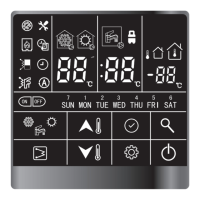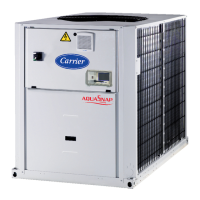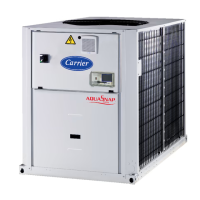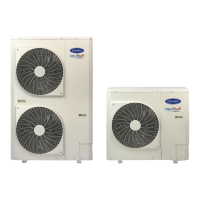31
10.4 - Minimum water ow rate
If the installation ow rate is below the minimum ow rate, there
is a risk of excessive fouling.
10.5 - Maximum water heat exchanger water
ow rate
This is limited by the permitted water heat exchanger pressure
drop. Also, a minimum water heat exchanger ∆T of 2.8 K must be
guaranteed, which corresponds to a water ow rate of 0.09 l/s per
kW.
10.6 - Water loop volume
10.6.1 - Minimum water loop volume
The minimum water loop volume, in litres, is given by the following
formula:
Volume (l) = CAP (kW) x N, where CAP is the nominal cooling
capacity at nominal operating conditions.
Application N
Air conditioning 2.5
(1)
Industrial process cooling (See note)
(1) For sizes 039 to 120, N can be increased up to 4 depending on the size of the
hot-water loop to prevent a water temperature drop during the defrost cycle.
NOTE: For industrial process cooling applications, where
high stability of the water temperature levels must be
achieved, the values above must be increased.
This volume is required to obtain temperature stability and
precision. To achieve this volume, it may be necessary to add a
storage tank to the circuit. This tank should be equipped with
bafes to allow mixing of the uid (water or brine). Please refer to
the examples below.
For the Buffer Tank Module option, the tank volume must be taken
into account: 250 litres.
Bad Good
Bad Good
10.6.2 - Maximum water loop volume
Units with hydraulic module incorporate an expansion tank that
limits the water loop volume. The table below gives the maximum
loop volume for pure water or ethylene glycol with various
concentrations.
30RQS/RQSY
039-078 without
buffer tank
080-160 without
buffer tank
Static pressure bar 1 2 3 1 2 3
Pure water litres 597 398 199 1741 1161 580
10% ethylene glycol l 471 314 157 1373 915 458
20% ethylene glycol l 389 259 130 1135 757 378
30% ethylene glycol l 348 232 116 1014 676 338
40% ethylene glycol l 289 193 96 843 562 281
30RQS/RQSY
039-078 with
buffer tank
080-160 with
buffer tank
Static pressure bar 1 2 3 1 2 3
Pure water litres 896 597 299 1741 1161 580
10% ethylene glycol l 706 471 235 1373 915 458
20% ethylene glycol l 584 389 195 1135 757 378
30% ethylene glycol l 522 348 174 1014 676 338
40% ethylene glycol l 434 289 145 843 562 281
If the total system volume is higher than the values given above,
the installer must add another expansion tank, suitable for the
additional volume.
Note : Take into account the buffer tank volume (250 litres)
10 - APPLICATION DATA

